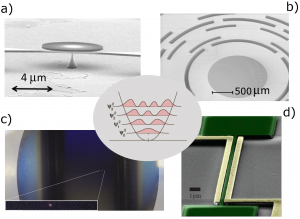QuaSeRT
Optomechanical quantum sensors at room temperature
The research in cavity optomechanics has recently achieved a major breakthrough: the first observation of quantum phenomena in cryogenic, optically cooled mechanical resonators (i.e., actually in macroscopic objects), as well as in the electromagnetic field interacting with such resonators. These results open the way to the exploitation of optomechanical systems as quantum sensors.
The main target of this project is indeed the creation of optomechanical sensing devices achieving the quantum limit in the measurement process, and exploiting peculiar quantum properties, of both the mechanical oscillator and the interacting radiation field, to enhance the efficiency of the measurement and to integrate the extracted information in quantum communication systems. We will develop three different platforms that, according to the present state of the art, are the most suitable to achieve our goal: (i) semiconductor nano-optomechanical disks (ii) tensioned dielectric membranes (iii) levitating nanoparticles. This parallel approach allows increasing the success probability, to extend the operating frequency range and diversify the systems for a larger versatility. Moreover, in order to study specific quantum protocols, we will exploit nano-electro-mechanical systems which have been shown to be the most suitable classical test-bench for this purpose thanks to their long coherence even at room temperature and their unprecedented control. Mechanical and optical properties of the different resonators will be improved, choosing innovative paths to advance the state of the art, in order to increase the coherent coupling rate and reduce the decoherence rate, eventually achieving quantum performance of the devices at room temperature, a crucial requirement for a realistic application scenario as sensors. Producing and manipulating quantum states of a sensor is an important pre-requisite for the quantum revolution, e.g., for implementing a quantum network that collects information from the environment and transfers it into quantum communication channels. We will produce prototype portable sensing systems, evaluate and compare the performance of the different platforms as acceleration sensors, study the possibilities of system integration and of functionalization for future extended sensing capability.

- GaAs waveguide/disk integrated optomechanical device.
- High-stress silicon nitride membrane (100 nm thick) with on-chip mechanical filtering system.
- Silica nanoparticle trapped in an optical cavity.
- High-stress silicon nitride nanobeam with electrodes used to polarize and resonantly excite the beam.
CONSORTIUM
- Coordinator: Francesco Marin (CNR-INO, IT)
- Eva Weig (University of Konstanz, DE)
- Nikolai Kiesel (University of Vienna, AT)
- Ivan Favero (Laboratoire Matériaux et Phénomènes Quantiques, FR)
- Kjetil Borkje (University College of Southeast Norway, NO)
- Pasqualina Sarro (TU Delft, NL)
PROJECT PRESENTATION: Presentation_QuaSeRT
MID-TERM REPORTING: Presentation of the mid-term results of the project
FINAL REPORTING: Presentation of the final results of the project
PROJECT WEBSITE: https://quasert.wordpress.com/








